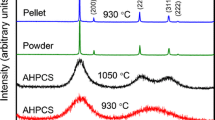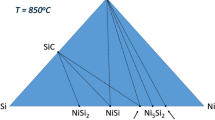Abstract
Electrophoretic Deposition (EPD) was used to deposit a mixture of SiC or Si3N4 “filler” and reactive carbon (graphite and carbon black) particles onto various SiC or Si3N4 parts in preparation for reaction bonding. The particles had gained a surface charge when mixed into an organic liquid consisting of 90 w % acetone + 10 w % n-butyl amine to form a slurry. The charged particles then moved when placed under the influence of an electric field to form a “green” deposit on the ceramic parts. The green parts were then dried and subsequently joined using a reaction bonding method. In this reaction bonding, molten Si moves into the joint via capillary action and then dissolves carbon and precipitates additional SiC. An optimum mixture of SiC “filler” to C powder ratio of 0.64 was identified. Residual un-reacted or “free” Si was minimized as a result of selecting powders with well-characterized particle size distributions and mixing them in batch formulas generated as part of the research. Image analysis of resulting microstructures indicated residual “free” Si content as low as 7.0 vol % could be realized. Seven volume percent compares favorably with the lowest “free” Si levels available in experimental samples of bulk siliconized (reaction-bonded) SiC manufactured using conventional reaction-bonding techniques. The joints retained the residual silicon over a large number of high-temperature thermal cycles (cycling from below to above the melting point of silicon). Comparisons to commercial reaction-bonded SiC indicated the majority of residual silicon of the joint was retained in closed porosity. This infers that parts made with these joints might be successfully utilized at very high temperatures. It was demonstrated that the EPD technique could be applied to butt, lap, and scarf type joints, including the capability to fill large gaps or undercut sections between parts to be joined. The overall results indicate that EPD, combined with reaction bonding, should allow for the fabrication of large complex structures manufactured from smaller components consisting of silicon carbide or silicon nitride.
Similar content being viewed by others
References
B. H. Rabin, Mater. Sci. Eng. A130 (1990) L1.
T. Iseki, M. Imai and H. Suzuki, Yogyo-Kyokai-Shi 91 (1983) 259.
B. H. Rabin, in ORNL/FMP-92/1 Oak Ridge National Laboratory, Oak Ridge, TN, (July, 1992) p.131.
D. R. Behrendt, NASA Technical Memorandum 88837, October 1986.
M. Singh and D. R. Behrendt, NASA Technical Memorandum 105860, 1992.
D. R. Behrendt Idem., Materials Science and Engineeering A187 (1994) 183.
D. R. Behrendt Idem. J. Mater. Res. 9 (1994) 1701.
D. R. Behrendt Idem., Materials Science and Engineering A194 (1995) 193.
D. R. Behrendt and M. Singh, Journal of Materials Synthesis and Processing 2 (1994) 117.
S. K. Datta, N. Simhai, S. N. Tewari, J. E. Gaticaand M. Singh, Metallurgical and Materials Transactions A 27A (1996) 3369.
M. Singh, J. of Materials Science Letters 17 (1998) 459.
B. H. Rabin and G. A. Moore, J. Mater. Synthesis and Proc. 1 (1993) 195.
G. A. Moore Idem. in Mater. Res. Soc. Symp. Proc. (Materials Research Society, Pittsburgh, PA, 1993) Vol. 314, p. 197.
G. A. Moore Idem. “Ceramic Trans., vol 35: Structural Ceramics Joining II” (The American Ceramic Society, Westerville, OH, 1993) p. 292.
G. A. Moore Idem. in “Silicon-Based Structural Ceramics, 1993,” edited by B. Sheldon (The American Ceramic Society, Westerville, OH,1993).
P. Colombo, V. Sglavo, E. Pippel and J Woltersdorf, J. of Materials Science 33 (1998) 2405.
R. Silberglitt and G. A. Danko, in Proceedings of the 22nd Annual Conference on Composites, Materials and Structures, Cocoa Beach, FL, January 29, 1998, edited by M.M. Opeka (CMC3 Committee ), p. 1187.
P. Sarkar and P. S. Nicholson, J. Am. Ceram. Soc. 79 (1996) 1987.
B. Cabot and A. Foissy, J. of Materials Science 33 (1998) 3945.
L. Vandeperre, O. Van der biest, F. Bouyer and A. Foissy, Bulletin of The American Ceramic Society 77 (1998) 53.
“TECHNI-DM Process” brochure available from Technic Inc., 1170 Hawk Circle, Anaheim, CA 92807 (phone: 714–632–0200).
Silicon nitride parts (Grade AS800) furnished courtesy of Charles Gasdaska, Allied Signal Inc., Research Center, PO Box 1021, Morristown, NJ 07960.
Media Cybernetics L.P., 8484 Georgia Avenue, Silver Spring, MD, 20410 (phone 301–495–3305).
ASTM F19–64 (Reapproved 1995), “Standard Test Method for Tension and Vacuum Testing Metallized Ceramic Seals”.
R. E. Cameron, USA Microscopy and Analysis, (May 1994) 17
Author information
Authors and Affiliations
Rights and permissions
About this article
Cite this article
Lessing, P.A., Erickson, A.W. & Kunerth, D.C. Electrophoretic deposition [EPD] applied to reaction joining of silicon carbide and silicon nitride ceramics. Journal of Materials Science 35, 2913–2925 (2000). https://doi.org/10.1023/A:1004766424209
Issue Date:
DOI: https://doi.org/10.1023/A:1004766424209




